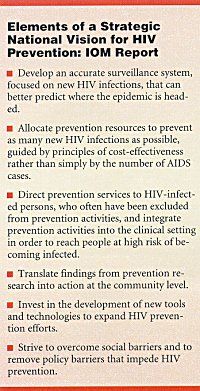IOM Recommends New Direction for HIV Prevention
WASHINGTON-Two decades after the first case of AIDS was recognized in the United States, “the nation does not have a comprehensive, effective, and efficient strategy for preventing the spread of HIV,” the Institute of Medicine (IOM) said in a new report.
WASHINGTONTwo decades after the first case of AIDS was recognized in the United States, the nation does not have a comprehensive, effective, and efficient strategy for preventing the spread of HIV, the Institute of Medicine (IOM) said in a new report.

A national strategy focused on better tracking of HIV infections and funding of the most cost-effective prevention programs could significantly cut new infections, the IOM said. The report was sponsored by the Centers for Disease Control and Prevention (CDC).
Thousands of new HIV infections could be avoided each year if we gave greater emphasis to prevention and were smarter in the way we spent our prevention dollars, said Harvey Fineberg, MD, PhD, provost of Harvard University, and co-chair of the committee that wrote the report.
Current epidemiologic surveillance focuses mainly on AIDS cases, where diagnosis lags behind HIV infection by 10 years or longer. While this approach may be useful for allocating funds for treatment, it is an inappropriate basis for allocating prevention services, the report said. This is because the AIDS epidemic is shifting, with the number of new AIDS cases declining dramatically among homosexual men and increasing considerably among women, minorities, and adolescents.
The current epidemiological surveillance system does not provide a complete or accurate picture of the incidence of HIV infection, said James Trussell, PhD, associate dean, Woodrow Wilson School of Public and International Affairs, Princeton University, and co-chair of the study committee. Todays surveillance system looks at the past rather than to the future and tracks where the epidemic has been rather than where it is going.
Rather than trying to count every newly infected person, the committees approach to surveillance would estimate the number of new infections by testing a statistically valid sample of those at the highest risk.
These individuals would be drawn from sentinel sites, including health care facilitiessuch as clinics specializing in sexually transmitted diseases, tuberculosis, substance abuse treatment, and family planningwhere at-risk people are likely to seek care.
Overcoming Social Barriers
Social and political pressures have led to policy and legal obstacles that block the use of proven prevention strategies. These laws and policies should be abolished, the committee said, including elimination of federal, state, and local requirements that public funds be used for abstinence-only sex education. The federal government has appropriated $250 million to be spent over 5 years for abstinence-only programs without any evidence that this approach is effective. Yet, the report said, comprehensive sex education and condom availability have been shown to reduce the risk of HIV and other sexually transmitted diseases without promoting sexual activity.
Federal and state barriers to the adoption of clean needle programs for drug users also should be lifted, the committee said. There is clear evidence that these programs avert new HIV infections without increasing the level of substance abuse.
Routine evaluations of the cost-effectiveness of HIV prevention interventions are needed so that interventions that do not work or that are very expensive in relation to the number of infections they prevent could be abandoned, the committee said.
Another important step is to make better use of the opportunities presented by clinics and doctors offices to deliver prevention messages. Medical facilities that treat patients who are at high risk or are already infected should routinely take sexual and drug histories, provide counseling and behavior modification, and offer HIV tests, the committee said.
Federal agencies also should increase research funding to develop new or enhanced prevention technologies, especially female condoms, microbicides, new antiretroviral drugs, vaccines, and rapid testing methods for detection of HIV antibodies.
Newsletter
Stay up to date on recent advances in the multidisciplinary approach to cancer.
Elevating the Quality of Cancer Care via Cross-Department Collaboration
Experts from Sibley Memorial Hospital discuss how multidisciplinary work has enhanced outcomes such as survival and resource use at their institution.